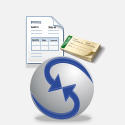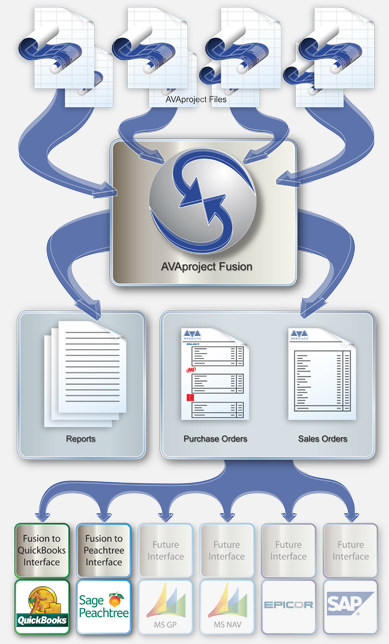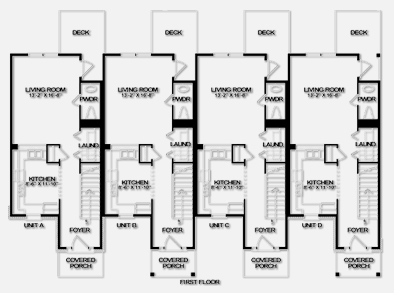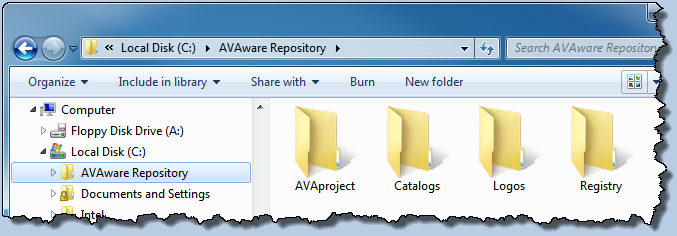
AVAproject Fusion: Accounting Series - All of the Features with None of the Restrictions
Schedule Writing: A Little Upfront Work Will Certainly Pay Off
A Look Inside the Development Process
AVAproject Tip: Sharing Resources (Catalogs & User Hardware)
Help Us Make AVAwire YOUR Resource

 U.S. Price Books: U.S. Price Books:
- Arrow
- Assa
- Burns
- Curries
- Dor-O-Matic
- Falcon
- Folger Adam
- Glynn Johnson
- HES
- Ives
- LCN
- Mesker
- Monarch
- PDQ
- Schlage
- Schlage ES
- Von Duprin
 Canadian Price Books: Canadian Price Books:
- Adams Rite
- Assa
- Corbin-Russwin
|

|

|
AVAproject Fusion: Accounting Series
All of the Features with None of the Restrictions
|

|
One of the most often requested features from AVAproject users is the ability to move data from project files into their accounting systems. After having developed and assisted in the development of countless such interfaces, AVAware developers have designed the ultimate integration solution; one that offers users the widest possible range of choices and functionality.
|
|
The logical extension of the detailing and estimating process is the eventual movement of project data into the company’s accounting or “ERP” system. AVAproject users, being a large and diverse pool of companies, employ a vast array of accounting solutions ranging from straightforward “off-the-shelf” packages like Intuit QuickBooks to extensive systems such as Microsoft Navision, Sage MAS and Epicor.
The simple fact of the matter is that no two companies are alike, so selecting a single accounting solution to fit them all is utterly preposterous. In July 2011, AVAware submitted an article for publication to Door & Hardware magazine entitled. “Software In An Integrated World”. In that article we discuss the realities of selecting an accounting product and integrating it into the operation. In addition, we discussed the many advantages to selecting an established accounting package.
Most competing developers of detailing and estimating applications offer one of two alternatives in respect of accounting solutions. Some have tried to create their own accounting while others have selected a specific commercial product to support. Beyond the obvious concerns with the former, both have the same inherent shortcoming; in both cases, the user is left with a very limited choice of accounting solution.
AVAware’s approach provides two very important advantages to our
|

A conceptual overview of the flow of data from AVAproject through Fusion and into various accounting packages by way of interface modules
|
|
users. To begin with, the powerful and flexible data extraction features of Fusion provide a perfect interface mechanism for preparing and exporting AVAproject data into the account system of choice. Fusion comes complete with a standardized set of accounting filters, reports and forms that can even be used to generate financial documents such as sales orders, purchase orders, etc. even with no accounting system at all.
The second advantage is of course that of choice. Initially, AVAware is offering modules to support two popular accounting platforms: Intuit QuickBooks and Sage Peachtree. Over the course of the next few months, we will be releasing interface modules for several additional packages. It’s our intention to be able to offer our
|
customers a choice of at least 6-8 different accounting systems before the end of this year.
It important to note that by using this interface model of integration, users are not limited to their first choice of accounting platform. Users can begin with whatever program suits their needs at the moment and then move to a different platform as they grow or their needs change. AVAware is unique in its ability to offer a solution that is able to scale with the customer’s company and its requirements. Moreover, if it turns out that one’s first choice of accounting solution is not the right fit for them, it’s a simple matter to move to an alternative platform without having to change your front-end application. Users can continue to benefit from their investment in
|
AVAproject and AVAproject Fusion, even if their accounting needs change from QuickBooks to something like Microsoft Navision. The only thing they would need to change beyond the accounting system itself is the Fusion interface module. All existing projects and project data could still be used as would the AVAproject application itself.
For additional information on AVAproject Fusion and the Fusion Accounting Series, please contact an AVAware sales representative or simply refer to our website.
|
Schedule Writing: A Little Upfront Work Will Certainly Pay Off
Authored by Chris Moore
|

|
As a newbie to the team, I was honored when asked to pull together some thoughts about a topic that is very close to many of our hearts - Schedule Writing. Working for a couple of very large Architectural Hardware Manufacturers for the past 28 years has certainly reinforced the value of well written Specifications and Schedules along with well detailed Submittals.
|
|
One of the biggest challenges for the Architectural Hardware Manufacturers is getting their new products out to the market along with the training of the Spec writers to ensure the many features and benefits of these products are clearly stated within the specification. Not only is this important for the myriad of new products hitting the streets but also for the foundation products we have used for years.
Ensuring the right products are used on the right applications is crucial. The knowledge base for these types of decisions is gained through experience as well as factory training when available. Most of us can immediately pull a list of materials required to fit up pretty much any opening in our heads. We subconsciously look at the opening with our thoughts; looking at door and frame construction, frequency of use, type of building, occupancy load, etc. I would imagine as you are reading this you can come up with many standard sets or groups of hardware that you use time and time again on similar applications. I would also suggest like many of us long time hardware
|
Take, for an example, Multi-Family Housing projects, be it Condos or Town Homes - The project is filled with very common types of doors which in many cases have the same hardware applied time and time again as these types of projects repeat. Another area that this use of pre-assigned groups works well in is school work. I have walked through hundreds of schools over the years and most are filled with top Grade hardware that repeats over and over again, Classroom, Storeroom, Office, Privacy, Passage, Stairwell, and Cross Corridor. This is a perfect environment for pre-established groups. This will provide speed when going through the project as well as ensuring the right mix of products are going on the opening to provide the end user with a long lasting, well specified opening.
I do understand that to many this may seem like a very basic and often done task. One of the enormous benefits AVAproject offers is that it can make your project creation much more efficient, along with ensuring your selection of tried and true applications
|
are there for you whenever you need to call on them. These groups can also be used to introduce the next generation to schedule writing. I have seen numerous Distributors take the time to sit down with the upcoming young ones wanting to get their fingers in the schedule writing process and walk them through the selection process of what goes on the typical openings and then allow them to create their own schedules based on pre-established groups. I can tell you I have dealt with some very good AHC’s in my day; most got their start this way. Software makes this learning curve much shorter.
I hope you have enjoyed this article. I am privileged to be part of this very dynamic team here at AVAware. The team here is extremely knowledgeable of our industry as well as brilliant when it comes to software design and development. On my travels I will check in from time to time to give you all another story. Stories are part of us all and are the means for us to learn not only about ourselves but in fact about the world around us.
|
|
people, many of our friends and loved ones have commented on our obsession with checking out hardware on almost every door we walk through. My children call me Rain Mans’ lost brother Hardware Man!
I am sure as avid Users of AVAproject, many of you have used this occupational obsession to its full advantage when creating Hardware Groups. This feature can save you time when applying hardware to your projects. I have had the benefit of dealing with many distributors over the years and can certainly appreciate this time saver. Distributors that specialize in certain types of work can benefit the most from this type of pre-planning.
|

|
A Look Inside the Development Process
|

|
As a software developer, we are guided by the feedback and requests of our user base. Hardly a day goes by without someone passing on a suggestion for a new feature or an enhancement to an existing one. As wonderful as this kind of creative feedback can be, it’s occasionally accompanied by a degree of impatience; users can’t wait to see their ideas come to life on the screen and often wonder what it takes to get them there.
|
|
AVAproject and AVAcad are extremely complex and mature products; they have been in use for over 13 years and by hundreds of users. Like most popular software packages they are continuously being enhanced and added to in the form of annual product updates.
At AVAware, our development cycle begins in the fall, usually right after the annual Door & Hardware Institute convention. In the months preceding this event, AVAware’s support team gathers feedback and suggestions from the existing user base. Customer suggestions are evaluated based on their merit and popularity as well as their viability in terms of the overall design vision for the software. Beyond that, the development team has their own list of development goals that reflect the direction in which the company envisions the software evolving.
After many discussions and brain-storming sessions involving everyone from the support and development team to the sales group, a revision list and timetable is established. Normally, AVAware plans for a spring release (May-June) of the major annual product updates. In order the achieve this, the new version of the software must be feature-complete and ready to begin internal testing at the end of March.
Although many software developers feel no compunctions about taking a piece of software from the developers’ desks to the customer overnight, this simply is not the way a responsible company operates. AVAware prides itself on the reliability of our products; never is a software version or “build” released to customers until it is thoroughly tested. Despite one’s best efforts, issues will always occur when dealing with complex technology-based products; it’s our opinion that these issues should be as few and as far between as is humanly possible.
For this reason, the first two weeks to a month following the completion of a feature-complete build is spent performing internal testing “scripts”.
|
These “scripts” are simply a pre-determined series of tests to put the software through; they are scripted to ensure that nothing is overlooked in the testing process and many combinations and permutations of real-world data are simulated. During this time, the “user interface” – the visual or cosmetic aspect of the new features is refined, and the accompanying documentation and online “help” are drafted.
Once internal testing has been completed to our satisfaction, the first “beta” build is offered to select users that have agreed to assist in the testing of the product. These users understand the risks associated with running “beta” software and do so understanding that any issues that arise may not be resolved before the final release. People become “beta” testers for many reasons, but there are two that are the most common. The first is that many people simply enjoy being a part of the development process. Beta testers work directly with the developers and many look forward to being the first to see and experience a new product release. The second is slightly more self-serving; because they do have the ears of the developers, beta-testers generally have the most outside influence on the way the final product will look.
Normally, AVAproject remains in “beta” for approximately two months, however this time period can be extended should significant issues with the new software arise. If a complete change of direction becomes necessary for any aspect of the software, it could very well set the process back to internal testing. At the end of this often arduous process however, our users are left with an extremely stable and reliable new product release.
Recognizing the importance of being ready to begin internal testing before April, it’s clear to see the importance of establishing a concise development plan. New features are identified and prioritized; based on importance of course, but also based on technical requirements. There are always “foundation” items that need to be completed first regardless of how
|
important other features may be. To extend the metaphor, the basement foundation has to get done first – no matter how important the master bedroom is to the home.
Although the development schedule is completed in the fall, it is by no means written in stone. Often times, the plan needs to be revised; new items are “slid” in while other may be moved to the back burner. There are countless reasons for such decisions - suffice it to say that the development process is a dynamic one. We create a development task list, often knowing that we won’t complete everything on the list. Our team works as hard as they can to get through as many of our planned enhancements as possible before reaching our testing deadline. This is the reason why very few announcements are made before the “beta” testing process begins. Unless a new feature is extremely high on the list and our developers are certain that it will make it to release, we avoid making any announcements.

A graphical representation of AVAware's development cycle
|
|
Two of the most popular aspects of AVAproject are its ability to be highly “customized” by each user to their particular needs and preferences, and its portability. This month’s tip discusses how to bring those two aspects together so that users can take advantage of both at the same time.
AVAproject is ridiculously customizable. Users of the software have access to multitudes of options and facilities that allow them to tailor the product to their specific work flow. One of the most prominent of these features is the “User Hardware” catalogs. AVAproject allows users to create two personal product catalogs; one for division-8 hardware and one for division-10.
Another powerful feature of AVAproject is the virtually unlimited portability it offers; users are not “tethered” to an office server or network. The software was designed to allow users to take their work with them and have access to their data without the need for network connections, VPNs, cloud servers, etc. Users can simply pack up their software, take it home, take it to a job site, work on an airplane or anywhere else they may find themselves with available time in their busy schedules. Upon their return to the office (or the nearest network connection), their project files can easily be uploaded to the network and made accessible to anyone else in the company they wish.
Many users are not aware that they can also take their custom-created User Hardware catalogs with them as well. Moreover, these catalogs can be shared with other people in the company. These “User” catalogs can just as easily be designated as “Company” catalogs; they can be placed on the network as easily as any other catalog and made available to everyone.
At their core, the User Hardware catalogs are technologically identical to the catalogs that AVAware creates and distributes. Also like AVAware catalogs, they reside in the AVAware Repository. The “Repository” is a group of directories that can reside either on the users’ individual machines or on the network, than contain essential resources such as catalogs and subscription files.

Typical contents of the AVAware Repository, installed at the default location
One of the convenient aspects of AVAware catalogs is that they are fully portable and self-installing. There is no “process” to install them on another system. If a user wants to take their User Hardware catalogs (or any other catalogs) home with them, they need only copy the “Catalogs” folder from inside their AVAware Repository and take it along with them. After installing the software on the home machine, simply copy the contents of the catalog folder into the repository on the new machine. That’s it. When AVAproject starts up, it will see the catalogs and load them automatically!
Bonus Tips: Sharing Resources (Subscriptions & View Styles)
|
Although AVAproject will automatically download your subscription file from the internet after installation, you can also install it manually if you’re in a location that doesn’t have an internet connection. Simply copy the “Registry” folder from inside the repository to your new machine. You subscription will travel with you and you’ll have access to your catalogs even if you don’t have an internet connection available.
|
|
AVAproject stores its custom “View Styles” in the AVAware Repository as well. To copy them, simply copy the contents of the “AVAproject” folder from with the repository. Please do not confuse this with the “AVAproject” folder in the “Program Files” directory - That one will be created automatically when you install AVAproject.
|
|
Network administrators that want to install AVAproject on several machines (i.e. multiple laptops for mobile users), can simply copy the entire repository immediately after performing one complete installation. This will save them the step of having to install catalogs individually on each machine.
|
|
|
Help Us Make AVAwire YOUR Resource
|

|
As we move into 2012, all of us at AVAware are enthusiastic about what promises to be the most productive and innovative year for software ever! Having recently celebrated our fifteenth year serving the architectural openings industry, we look forward to raising the bar even higher and bringing an exciting new level of technology and support to our customers.
|
|
The monthly AVAwire newsletter has become an important and valuable resource for many users of AVAware software products; it keeps them up to date on news releases and developments and offers insights into ways they can maximize their use of our products. Even beyond these valuable functions, we’ve tried to take AVAwire one step further. Business owners and operators today are faced with managing and making decisions based on more technological issues than ever before. It’s become virtually impossible to run a successful company today without having a considerable awareness of current technologies and their roles in the workplace. It’s no longer sufficient to simply be a great business person - today one is expected to make software purchase decisions with the expertise and insight of an engineer. The fact of the matter is that even those of us who make technology our
|
professions have to struggle to keep informed about changes and advances in the field. The “science” of software is progressing at a pace never seen before in any arena.
How then, is a business person expected to keep up? It’s doubtful that any one solution will completely answer that question, but we believe that industry resources such as AVAwire can be a step in the right direction. It’s for that reason that we’ve attempted to include articles about general technological issues in the software field that our users might be faced with. We’ve published articles dealing with such software “trends” as XML, SQL databases and network integration – all in an effort to help demystify these items and to provide a foundation on which decisions can be made.
The challenge for us, however, is knowing “how much” and “how far” to
|
take it. On one hand we want to be as comprehensive as possible, but at the same time we don’t want to inundate readers with excessive technical details. This is where we need your feedback.
Please help us to continue making AVAwire a valuable resource for yourself and the industry as a whole. Please take a moment and tell us what you think. What issues would you like to see covered in more detail? Are our technical articles easy or difficult to follow? Too basic or too advanced? Is there anything you feel we may have overlooked?
On behalf of everyone at AVAware, please accept out thanks for your valuable insights and suggestions.
|
|
We welcome any questions, comments or suggestions about any topic mentioned in this edition of AVAwire. Please visit our website for more information, or contact us directly at (416) 239-9099.
|
|